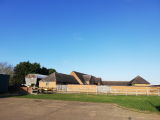Establishment of the National Vegetable Research Station in 1949

The year 2019 marked 70 years of research on vegetables and other crops at the Wellesbourne Campus. The Annual Reports are an excellent source of information and below are extracts from the First Annual Report 1950, published in 1951. ‘During the latter part of the 1939-45 war much thought was given to the needs of research in agriculture and horticulture in consequence of the necessity of increasing food production in Great Britain in the future. In this connection a Survey Group, appointed by the Agricultural Research Council, the Agricultural Improvement Council of the Ministry of Agriculture and Fisheries, and the Scottish Agricultural Advisory Council, recommended that a new Vegetable Research Station should be established in view of the great national interests involved and the limited facilities available at Cambridge, where investigations had been proceeding for several years under the auspices of the Ministry and the University. H.M. Treasury agreed to this proposal, and in 1947 a Governing Body for the new N.V.R.S. was established by the Minister of Agriculture and Fisheries and the Secretary of State for Scotland’. ‘In February 1948 the Governing Body appointed as the first Director, Dr J. Philp, a distinguished plant breeder who had much experience at home and abroad. His first duty was to seek for a site for the new station, a task which proved to be very arduous. Until the Governing Body was legally incorporated as the British Society for the Promotion of Vegetable Research in September 1949, the administrative arrangements were in the hands of the Ministry of Agriculture and Fisheries’. ‘The Director investigated 318 properties which were offered for sale and made 71 inspections. It was not until 29th September, 1949 that the Society obtained possession of the present site on lease from the Ministry of Agriculture which purchased the property on the recommendation of the Organising Committee’. ‘The site lies in Warwickshire, six miles east of Stratford-upon-Avon, five miles out of Warwick and one mile north of the village of Wellesbourne. It is almost in the centre of England, is easily reached by rail and road, and has soils and climate similar to the nearby Vale of Evesham where vegetable production is an important industry. The property consists of 280 acres of level land’. ‘Most of the natural requirements were met and in consequence the disadvantages were mainly of a type that could be overcome. There were, of course, no facilities in the form of laboratories and glasshouses for research and none of the buildings was suitable for conversion into laboratories. The property formed part of an estate where mixed farming was practiced and it was operated from another farmstead on the estate. Housing for staff was inadequate; there was no farmhouse and there were only three cottages, all in a poor state of repair. There was no electric power or piped water and a bridle path formed the means of access to the buildings’. |
|
OS Six-inch England and Wales, 1842-1952: The site of NVRS is to the east of Charlecote - top left on map. The builldings are marked as 'Cottage Farm' Courtesy of the National Library of Scotland.
